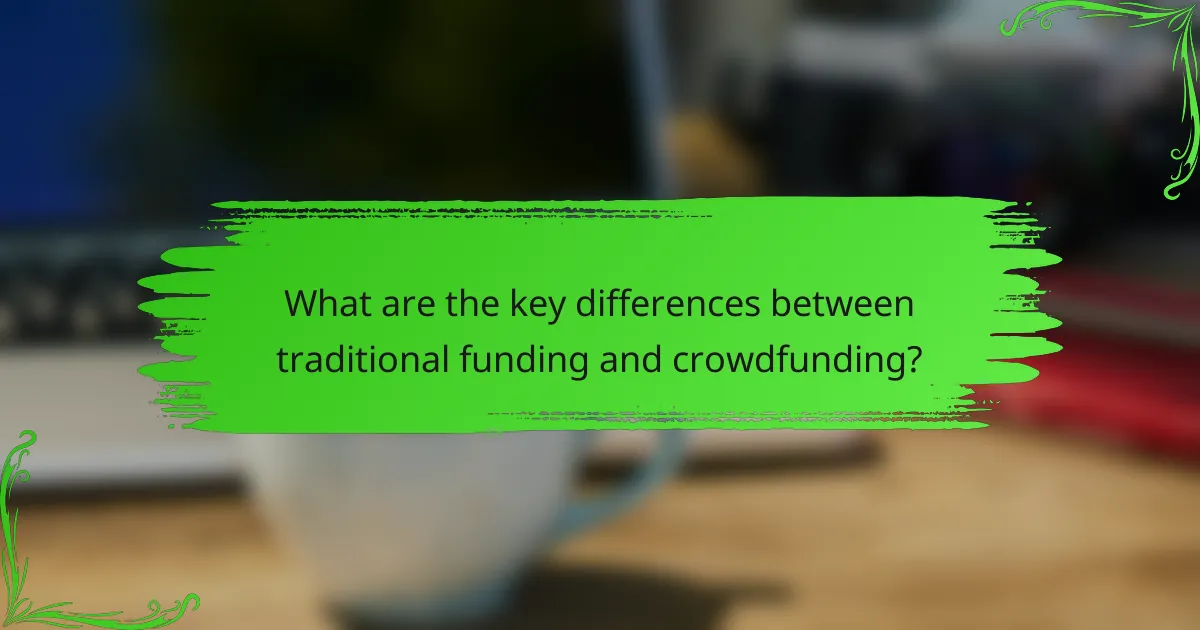When deciding between traditional funding and crowdfunding, it’s essential to understand the unique advantages each method offers. Traditional funding provides stability and larger sums of money through established financial relationships, making it suitable for businesses with a solid foundation. In contrast, crowdfunding allows for broader audience engagement and flexible funding options, appealing to startups seeking validation and marketing exposure. Choosing the right approach depends on your business needs and goals.

What are the advantages of traditional funding?
Traditional funding offers several key advantages, including established relationships with financial institutions, access to larger sums of money, lower risk of losing control over your business, and structured repayment terms. These factors can significantly benefit businesses seeking stability and growth.
Established relationships with banks
Having established relationships with banks can facilitate smoother funding processes. Banks are more likely to approve loans for businesses they know well, as they have a history of financial behavior to assess. This familiarity can lead to quicker decisions and potentially better terms.
Building these relationships often involves regular communication and maintaining a good credit score. Engaging with your bank through meetings or updates can enhance trust and improve your chances of securing funding when needed.
Access to larger sums of money
Traditional funding typically allows businesses to access larger sums compared to crowdfunding. Banks and financial institutions can provide loans that range from thousands to millions of dollars, depending on the business’s needs and creditworthiness. This is particularly beneficial for startups or expansions requiring significant capital investment.
For example, a small business might secure a loan of $100,000 to $500,000 for equipment purchases or facility upgrades, which would be challenging to achieve through crowdfunding platforms.
Lower risk of losing control
With traditional funding, business owners usually retain full control over their company. Unlike crowdfunding, which may require giving away equity or decision-making power to backers, traditional loans do not dilute ownership. This allows entrepreneurs to maintain their vision and direction without external influence.
However, it is essential to ensure that repayment terms are manageable to avoid financial strain, which could indirectly affect control if the business struggles to meet obligations.
Structured repayment terms
Traditional funding often comes with clearly defined repayment terms, making it easier for businesses to plan their finances. Loan agreements typically outline the repayment schedule, interest rates, and any fees, providing a predictable financial obligation.
This structure can help businesses manage cash flow effectively, as they can anticipate when payments are due and budget accordingly. Understanding these terms upfront is crucial to avoid surprises that could impact operational stability.

What are the advantages of crowdfunding?
Crowdfunding offers several key advantages, including access to a broader audience, validation of business concepts, flexible funding options, and enhanced marketing exposure. These benefits can significantly impact the success of a project or startup, making crowdfunding an appealing alternative to traditional funding methods.
Access to a wider audience
Crowdfunding platforms allow entrepreneurs to reach a diverse group of potential backers, including individuals who may not typically invest in startups. This access can lead to funding from thousands of supporters, increasing the chances of meeting financial goals.
By leveraging social media and online communities, campaigns can attract attention from various demographics, which is often more challenging with traditional funding sources. This broad reach can be particularly beneficial for niche products that resonate with specific interest groups.
Validation of business ideas
Launching a crowdfunding campaign serves as a litmus test for business ideas. If a project garners significant interest and funding, it indicates market demand and validates the concept before further investment.
Conversely, a lack of support may signal the need for adjustments or a complete reevaluation of the idea. This feedback loop is invaluable for entrepreneurs looking to refine their offerings based on real consumer interest.
Flexible funding options
Crowdfunding provides various funding models, such as rewards-based, equity, and donation-based options. This flexibility allows entrepreneurs to choose a structure that aligns with their business goals and target audience.
For instance, rewards-based crowdfunding can incentivize backers with products or services, while equity crowdfunding allows investors to gain a stake in the company. Understanding these options can help entrepreneurs select the best approach for their specific needs.
Marketing exposure during the campaign
Running a crowdfunding campaign inherently involves marketing efforts, which can significantly increase brand visibility. The process of promoting a campaign can attract media attention and engage potential customers long before the product launches.
Effective marketing strategies during the campaign can lead to lasting relationships with backers, who may become loyal customers. Utilizing storytelling and engaging content can enhance the campaign’s appeal and drive further interest in the business.

When should you choose traditional funding?
Traditional funding is ideal when you have a solid business foundation and require substantial financial backing. This approach often involves banks or investors who expect a clear repayment plan and oversight of the project.
For established businesses with credit history
Established businesses with a strong credit history are well-positioned to secure traditional funding. Lenders typically favor companies with proven track records, as they present lower risks. If your business has consistently generated revenue and maintained good credit, you may qualify for favorable loan terms.
Consider leveraging your credit history to negotiate lower interest rates or extended repayment periods. This can significantly reduce your overall financial burden.
When seeking significant capital investments
Traditional funding is often necessary for projects requiring large capital investments, such as real estate development or major equipment purchases. These investments usually exceed the limits of crowdfunding, making traditional routes more suitable.
When pursuing significant funding, prepare a detailed business plan that outlines your financial needs and projected returns. This will help convince lenders or investors of your project’s viability.
For projects requiring strict oversight
If your project demands rigorous oversight and compliance with regulations, traditional funding is often the better choice. Lenders typically require regular updates and detailed financial reporting, ensuring that the funds are used as intended.
Be prepared to adhere to strict guidelines and maintain transparency throughout the funding process. This can help build trust with your lenders and may lead to future funding opportunities.

When should you choose crowdfunding?
Crowdfunding is a viable option when you need to raise funds from a large number of people, often through online platforms. It’s particularly effective for projects that resonate with a community or have innovative concepts that traditional funding may overlook.
For startups with innovative ideas
Crowdfunding is ideal for startups that offer unique products or services that may not fit traditional funding models. By presenting your innovative idea to potential backers, you can gauge interest and secure funding without the need for extensive business plans or investor pitches.
Platforms like Kickstarter and Indiegogo allow you to showcase your concept through engaging videos and descriptions, attracting early adopters who believe in your vision. This can lead to funding in the low thousands to tens of thousands of dollars, depending on the project’s appeal.
When testing market demand
If you’re unsure about the market’s interest in your product, crowdfunding can serve as a valuable testing ground. By launching a campaign, you can directly measure consumer interest and willingness to pay before fully committing to production.
Successful campaigns can provide insights into pricing strategies and potential customer demographics. Aim for a funding goal that reflects your production costs, and consider offering tiered rewards to incentivize backers at various levels.
For community-driven projects
Crowdfunding shines for projects that have a strong community focus, such as local initiatives or social causes. Engaging your community can foster a sense of ownership and support, making it easier to reach your funding goals.
Utilize platforms that cater to community-driven projects, such as GoFundMe or Patreon, which allow for ongoing support. Clearly communicate the project’s impact on the community to encourage contributions, which can range from small donations to larger sponsorships.

What are the key differences between traditional funding and crowdfunding?
Traditional funding typically involves securing capital from established financial institutions or investors, while crowdfunding relies on raising small amounts of money from a large number of people, usually via online platforms. Understanding these differences can help you choose the right funding method for your project or business.
Traditional Funding Overview
Traditional funding includes options like bank loans, venture capital, and angel investments. These methods often require a detailed business plan, creditworthiness, and sometimes collateral. Investors in traditional funding expect a return on their investment, which can come in the form of equity or interest payments.
For example, a startup seeking a bank loan might need to present financial projections and demonstrate a solid repayment plan. This process can take weeks or months, depending on the institution’s requirements.
Crowdfunding Overview
Crowdfunding allows individuals or businesses to raise funds through online platforms by appealing to the public. This method can be donation-based, reward-based, or equity-based, depending on what the backers receive in return. Crowdfunding campaigns usually have a set time frame and funding goal.
For instance, a creative project might use a reward-based crowdfunding platform to offer backers exclusive merchandise or early access to the product. Campaigns can be launched quickly, often within days, but success depends on effective marketing and outreach.
When to Use Traditional Funding
Traditional funding is best suited for established businesses with a proven track record or those requiring significant capital for expansion. It is ideal when you need larger sums of money, often in the tens of thousands to millions of dollars.
Consider traditional funding if you have a solid business plan, existing revenue streams, and the ability to meet repayment obligations. This method can provide stability and long-term relationships with investors.
When to Use Crowdfunding
Crowdfunding is a great option for startups, creative projects, or businesses looking to validate their ideas without incurring debt. It works well when you need smaller amounts of capital, typically ranging from a few hundred to tens of thousands of dollars.
Use crowdfunding if you want to engage directly with your audience and build a community around your product. However, be prepared for the effort required in marketing your campaign and managing backer expectations.
